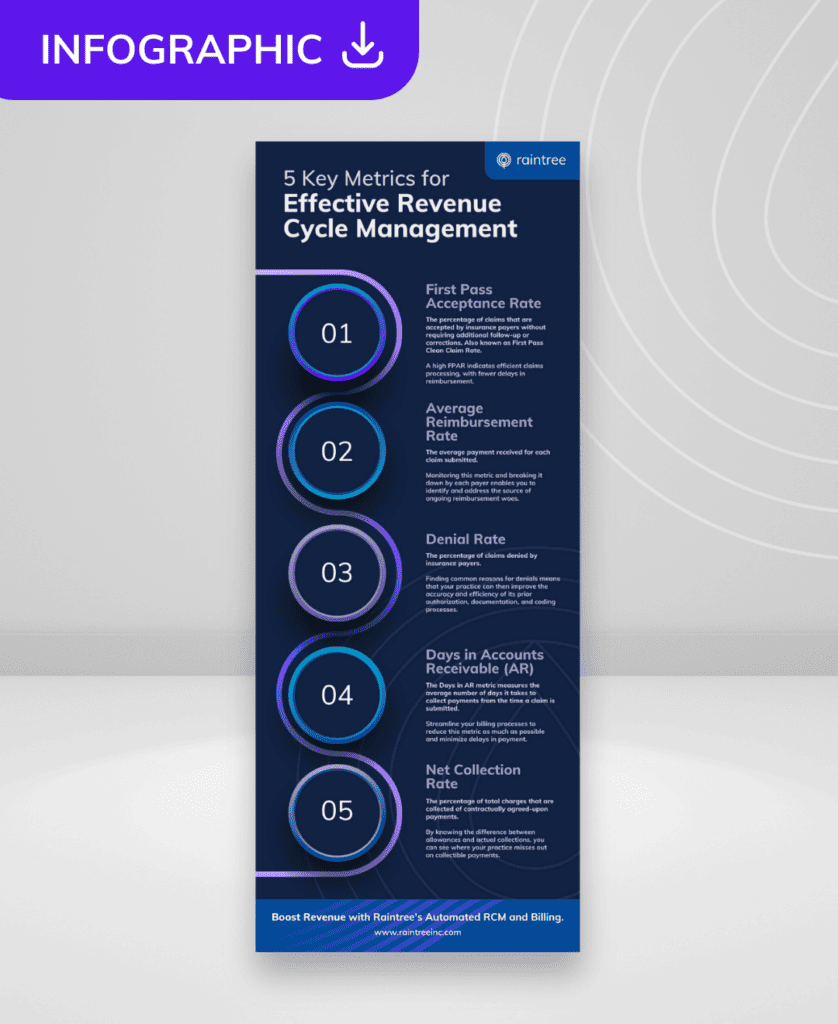Today, outpatient rehabilitation therapy practices face numerous challenges when it comes to financial stability and success. From declining reimbursements to staffing shortages, it’s more crucial—and complicated—than ever to keep your bottom line from hitting rock bottom.
To succeed in troubled waters, you need to run a tight ship. And the right metrics will tell you whether your practice is going to sink or sail!
Don’t lose track of your most important data points. Instead, set your sights on the 5 key revenue cycle management metrics that can unlock the door to financial success in outpatient practice management!
Understanding RCM
Revenue Cycle Management (RCM) encompasses the entire lifecycle of a patient’s account, starting from referral and appointment scheduling, through service provision, claims submissions, and collection from payers or patients. It is a complex process that requires meticulous attention to detail and effective management to ensure timely and accurate payments.
What is Revenue Cycle Management?
DeVry University defines RCM as the process of “tracking and analyzing revenue received from patients during the course of their care process. The cycle begins when the first appointments are booked and concludes once the final balance of their cost of care is paid.”
The Power of Data-Driven Revenue Cycle Management
Strong RCM depends on your data. By tracking and monitoring RCM metrics, healthcare organizations and outpatient practices can gain valuable insights into their financial performance and identify areas for improvement.
How can you measure RCM efficiency and productivity?
Your RCM tools and teams should work together to create a clear image of your financial successes, pitfalls, and potential improvements. Depending on the size and needs of your practice, you may need out-of-the-box RCM reporting tools, scalable and customized solutions, or outsourced revenue cycle management.
Implementing Business Intelligence tools is one way to help your teams identify data-driven strategies to improve revenue. In Therapy Matters podcast episode “Increasing Profit with Business Intelligence,” Raintree’s VP of Business Development, Bill Sillar, spoke about how Business Intelligence tools allow practices to start “looking at [your revenue cycle] from 360 degrees. Not just from a financial [or] a billing standpoint.” Breaking down the data into actionable insights means “also looking at how [you] gain top-line revenue.”
Related Posts:
- 6 Most Popular Patient Payment Options in 2023
- Tackle the Denials Backlog: 3 Tips for Claims Denial Management and Prevention
- Top Financial Reports for Your Therapy and Rehab Practice
The Benefits of Monitoring Revenue Cycle Management Metrics
Outpatient rehabilitation therapy practices can stand to gain a lot when they level up their revenue cycle’s reporting processes. For example:
- Improved financial performance. Collecting and reviewing data over time allows practices to identify inefficiencies, reduce denials, and increase revenue. It enables better decision-making and continual optimization.
- Enhanced operational efficiency. Gain insights into the effectiveness of various processes and workflows. By identifying bottlenecks and areas for improvement, practices can streamline operations, reduce administrative burdens, and improve overall efficiency.
- Proactive problem solving. If you can’t identify issues and negative trends in real time, you’re losing money in the long run. By addressing potential problems promptly, practices can minimize the impact on revenue and prevent complications from snowballing.
Use These 5 KPIs to Improve Outpatient Practice Profitability
Key Performance Indicators (KPIs) are objective, quantifiable metrics that can indicate the success of your practice. Data analysis of KPIs over time allows you to create benchmarks for measuring performance, which helps form the foundation for your business intelligence reporting capabilities.
Several data points are particularly important for keeping track of cash flow at outpatient rehabilitation therapy practices. We recommend tracking these top five key metrics for billing and RCM:
- First Pass Acceptance Rate
- Average Reimbursement Rate
- Denial Rate
- Days in Accounts Receivable (AR)
- Net Collection Rate

Download this infographic to learn about 5 key metrics for effective revenue cycle management.
Raintree’s Interoperable RCM and Billing Platform
Defining key metrics for revenue cycle management is no longer an option but a necessity for outpatient rehabilitation therapy practices’ financial success. By harnessing the power of data, practices can identify opportunities, optimize processes, and drive their practice towards improved financial performance and operational efficiency.
Raintree can help you unlock the potential to thrive in today’s competitive healthcare landscape. We provide a powerful platform designed specifically for Therapy and Rehab practices to help you deliver top-quality care while keeping costs low.
Don’t waste another second, or another penny. Request a demo to see how Raintree can boost your RCM efficiency and drive up to 40% more revenue!


